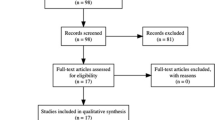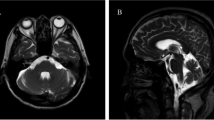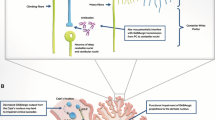Abstract
Background
To report three cases of autoimmune cerebellar ataxia related to anti-delta/notch-like epidermal growth factor-related receptor (Tr/DNER) antibodies.
Case presentation
Patients with unknown cerebellar ataxia were screened with autoimmune cerebellar ataxia (ACA)-related antibody panel. The anti-Tr antibody was positive in three female patients in whom the onset ages were 43 years, 35 years and 43 years old. The antibody titres of serum and cerebrospinal fluid were all 1:32. Cerebral ataxia was the most prominent presentation. Mild cerebellar atrophy was found in one of the patients. Immunotherapy was effective in all three patients.
Conclusion
The Tr antibody is associated with autoimmune ataxia, and it has been suggested that the anti-Tr antibody should be tested in patients with cerebellar ataxia who are negative for routine ACA antibodies. Early immunotherapy may improve patient prognoses.


Similar content being viewed by others
Data availability
All the data generated or analysed during this study are included in this published article.
Abbreviations
- Tr/DNER :
-
Anti-delta/notch-like epidermal growth factor-related receptor
- ACA :
-
Autoimmune cerebellar ataxia
- Homer-3 :
-
Homer protein homologue 3
- PCA-2 :
-
Purkinje cell antibody 2
- VGCC :
-
Voltage-gated calcium channel
- mGluR1 :
-
Metabolic glutamic acid receptor 1
- TRIM9 :
-
Tripartite motif−containing 9
- NMDAR :
-
N−methyl−D−aspartate receptor
- LGI1 :
-
Leucine−rich glioma inactivated−1
- GABAR :
-
Gamma−aminobutyric acid receptor
- CASPR2 :
-
Contactin−associated protein like 2
- AMPAR1 :
-
α−Amino− 3−hydroxy−5−methyl−4−isoxazolepropionic acid receptor 1
- AMPAR2 :
-
α−Amino−3−hydroxy−5−methyl−4−isoxazolepropionic acid receptor 2
- DPPX :
-
Dipeptidyl−pepti dase−like protein−6
- GAD65 :
-
Glutamic acid decarboxylase 65
- ZIC4 :
-
Zinc finger protein 4
- ITPR1 :
-
Inositol 1, 4, 5−trisphosphate receptor 1
- NCDN :
-
Neurochondrin
- PCA−2 :
-
Purkinje cell antibody 2
- CARPVII :
-
Carbonic anhydrase−related protein VII
- TBA :
-
Tissue-based assay
- CBA :
-
Cell-based assay
- FITC :
-
Fluorescein isothiocyanate
- PBS :
-
Phosphate buffer saline
- CSF :
-
Cerebrospinal fluid
- MRI :
-
Magnetic resonance imaging
- MRA :
-
Magnetic resonance angiography
- CT :
-
Computed tomography
- OB :
-
Oligoclonal band
- SOB :
-
Serum oligoclonal band
- mRS :
-
Modified Rankin Scale
- MP :
-
Methylprednisolone
- MBP :
-
Myelin basic protein
- VEP :
-
Visual evoked potential
- HD :
-
Hodgkin’s disease
- PCD :
-
Paraneoplastic cerebellar degeneration
- IVIG :
-
Intravenous immune globulin
- MMF :
-
Mycophenolate mofetil
- IHC :
-
Immunohistochemistry
- PC :
-
Purkinje cell
References
Xu X, Ren H, Li L, Wang J, Fechner K, Guan H (2019) Anti-Homer-3 antibody associated cerebellar ataxia: a rare case report and literature review. J Neuroimmunol 330:155–158
Jarius S, Wildemann B (2015) “Medusa-head ataxia”: the expanding spectrum of Purkinje cell antibodies in autoimmune cerebellar ataxia. Part 1: anti-mGluR1, anti-Homer-3, anti-Sj/ITPR1 and anti-CARP VIII. Journal of Neuroinflammation 12:166
Jarius S, Wildemann B (2015) “Medusa head ataxia”: the expanding spectrum of Purkinje cell antibodies in autoimmune cerebellar ataxia. Part 2: anti-PKC-gamma, anti-GluR-delta2, anti-Ca/ARHGAP26 and anti-VGCC. Journal of Neuroinflammation. 12:167
Jarius S, Wildemann B (2015) “Medusa head ataxia”: the expanding spectrum of Purkinje cell antibodies in autoimmune cerebellar ataxia. Part 3: anti-Yo/CDR2, anti-Nb/AP3B2, PCA-2, anti-Tr/DNER, other antibodies, diagnostic pitfalls, summary and outlook. Journal of Neuroinflammation 12:168
Do LD, Gupton SL, Tanji K, Bastien J, Brugière S, Couté Y et al (2019) TRIM9 and TRIM67 are new targets in paraneoplastic cerebellar degeneration. Cerebellum 18:245
Joubert B, Gobert F, Thomas L et al (2017) Autoimmune episodic ataxia in pat ients with ant i-CASPR2 antibody-associated encephalitis. Neurol Neuroimmunol Neuroinflamm 4(4):e371
Barsottini OG, Albuquerque MV, Braga-Neto P, Pedroso JL (2014) Adult onset sporadic ataxias: a diagnostic challenge[j]. Arq Neumpsiquiatr 72(3):232–240
Mitoma H, Adhikari K, Aeschlimann D, Chattopadhyay P, Hadjivassiliou M, Hampe CS et al (2016) Consensus paper: neuroimmune mechanisms of cerebellar ataxias. Cerebellum 15:213–232
Graus F, Dalmau J, Valldeoriola F, Ferrer I, Rene R, Marin C et al (1997) Immunological characterization of a neuronal antibody (anti-Tr) associated with paraneoplastic cerebellar degeneration and Hodgkin’s disease. J Neuroimmunol 74:55–61
Bernal F, Shams’ili S, Rojas I, Sanchez-Valle R, Saiz A, Dalmau J et al (2003) Anti-Tr antibodies as markers of paraneoplastic cerebellar degeneration and Hodgkin’s disease. Neurol 60:230–4
De Graaff E, Maat P, Hulsenboom E, van den Berg R, van den Bent M, Demmers J et al (2012) Identification of delta/notch-like epidermal growth factor-related receptor as the Tr antigen in paraneoplastic cerebellar degeneration. Ann Neurol 71:815–824
Probst C, Komorowski L, de Graaff E, van Coevorden-Hameete M, Rogemond V, Honnorat J et al (2015) Standardized test for anti-Tr/DNER in patients with paraneoplastic cerebellar degeneration. Neurol Neuroimmunol Neuroinflamm 2(2):e68
Mitoma H, Hadjivassiliou M, Honnorat J (2015) Guidelines for treatment of immune-mediated cerebellar ataxias. Cerebellum Ataxias 2:14
Mitoma H, Manto M, Hampe CS (2018) Time is cerebellum. Cerebellum 17:387–391
Funding
The authors acknowledge the support of Hebei Natural Science Foundation Precision Medicine Joint Project (Grant No. H2020201206) and the Central Government Guided Local Science and Technology Development fund project of Hebei Province (Grant No. 216Z7711G).
Author information
Ethics declarations
Ethical approval
This study was approved by the Medical Ethics Committee of Peking Union Medical College Hospital.
Informed consent
Written informed consents were obtained from the legal guardians of the patients.
Consent to participate
We confirm that we have read the Journal’s position on issues involved in ethical publications and affirm that this report is consistent with those guidelines.
Consent for publication
Written informed consents to publish this information were obtained from the patients and their legal guardians.
Competing interests
The authors declare no competing interests.
Additional information
Publisher's note
Springer Nature remains neutral with regard to jurisdictional claims in published maps and institutional affiliations.
Rights and permissions
Springer Nature or its licensor holds exclusive rights to this article under a publishing agreement with the author(s) or other rightsholder(s); author self-archiving of the accepted manuscript version of this article is solely governed by the terms of such publishing agreement and applicable law.
About this article
Cite this article
Cai, Y., Liu, J., Ren, H. et al. Anti-Tr/DNER antibody–associated cerebellar ataxia: three rare cases report and literature review. Neurol Sci 44, 397–403 (2023). https://doi.org/10.1007/s10072-022-06389-x
Received:
Accepted:
Published:
Issue Date:
DOI: https://doi.org/10.1007/s10072-022-06389-x




